15 December 2022
Peace in No Man’s Land? The truth behind the Christmas Truce
The story of the Christmas Truce has entered legend but was it really all peaceful on the Western Front on Christmas Day 1914?
The Christmas Truce WW1

The Christmas Truce as depicted in a December 1914 edition of the London Illustrated News (Wikimedia Commons)
“It’ll all be over by Christmas…”
Since the guns of August opened fire in wrath across France and Belgium’s virginal green fields, the war in Europe had already claimed hundreds of thousands of lives in 1914.
The first six months of World War One had put paid to the optimistic idea that this would be a short war. The flower of French, German, and Commonwealth youth had already been cut down. Soldiers on both sides, young men in their prime, had fallen victim to the unceasing horrors of modern combat.
For context, the British would take close to 60,000 casualties at the First Battle of Ypres in October 1914 alone.
By the end of the year, the British and Commonwealth forces had lost just over 42,250 dead in fighting around the world. That may seem low against the other major combatants’ war dead, with hundreds of thousands killed, but keep in mind that Britain’s army was much smaller than France’s or Germany’s when war broke out in August 1914.
What had started as a war of manoeuvre had begun to slow. The mad dash for the sea, the Miracle on the Marne, and the first clashes at Ypres had already taken place. No side, neither the Entente nor Central Powers, had gained a major advantage over the other.
As summer gave way to Autumn, and the heat subsided and rain set in, vast trench networks began to spread across northern France and Southern Belgium.
The vision of World War One that dwells within the public imagination was beginning to form.
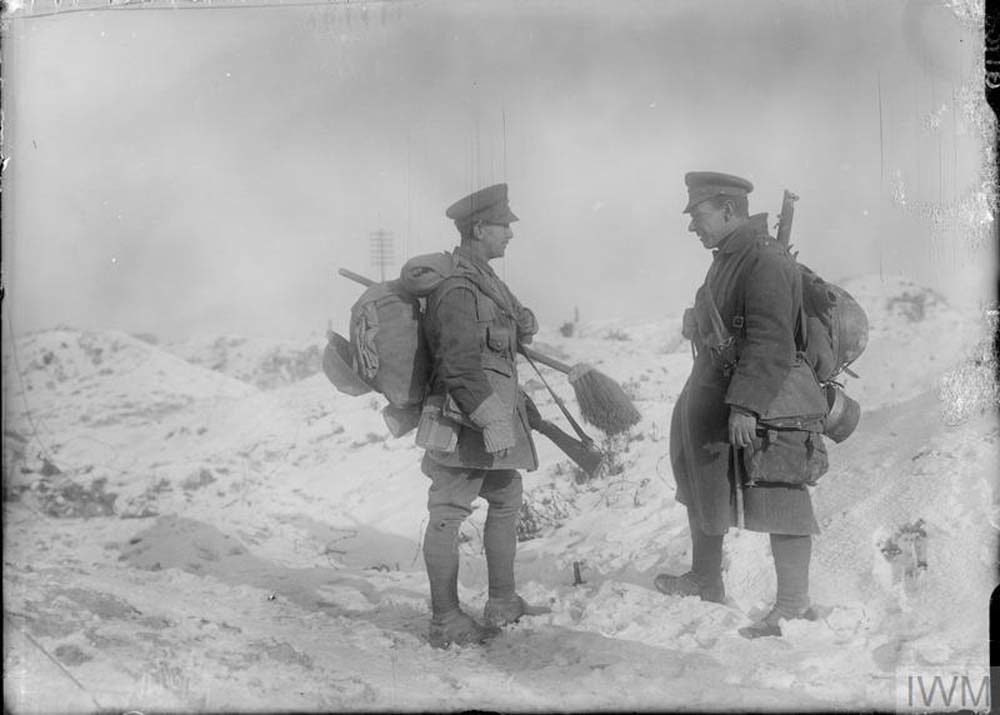
British soldiers on the snowy Western Front (© IWM Q 1708)
Deep trenches were dug. Razor sharp barbed wired bushels were laid down. Shells had started carving the once-green earth into a barren pox-scarred moonscape of craters. No Man’s Land was taking shape.
In the Great War, tactics would gradually develop so attacking armies could eventually take, hold, and break through trench systems. In the opening months of the war, however, the advantage lay very much with the defender.
The machine gun and the artillery piece made attacking incredibly difficult. Death tolls would be high and continue to spiral over the course of the war.
As the first snows lay a wintery blanket over the WW1 battlefields, winter 1914 had bought stalemate to the Western Front.
Winter operations
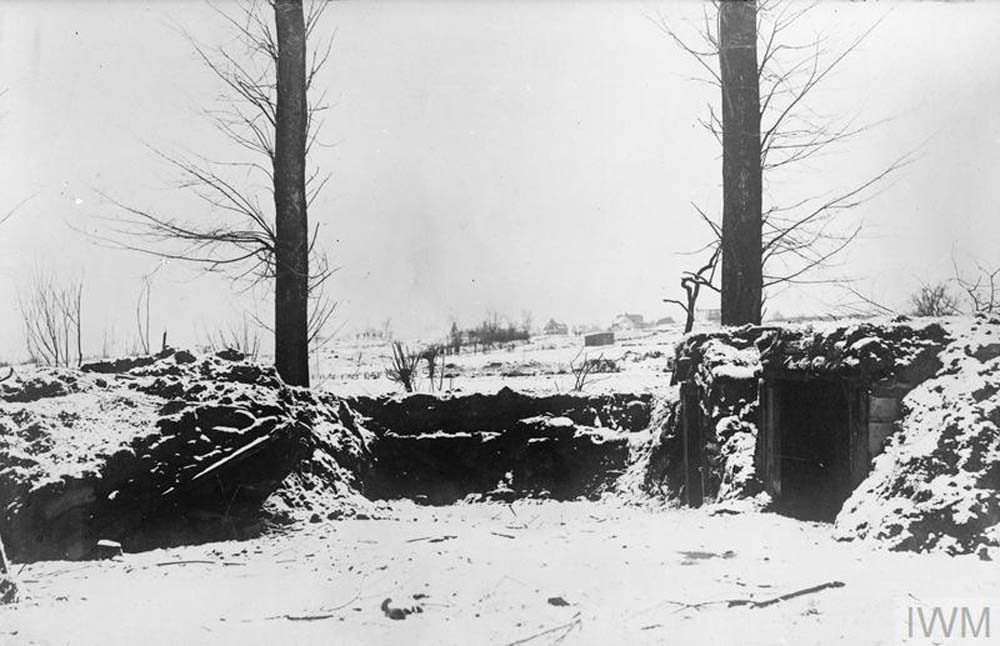
A German position covered in snow (© IWM Q 45589)
Fighting continued to rage across the Western Front in winter 1914.
The British Expeditionary Force and the Indian Corps were involved in heavy fighting around Festubert in northern France, in late November, for example.
The British and Indians would see action throughout December.
Between 14-22nd December, British and Indian troops were involved in attacks across a wide front in Belgium, supporting the French. They were also engaged in further fighting around Arras and Givenchy, France, showing not all was peaceful before the miraculous festive truce.
Christmas in the trenches: peace breaks out
It started on Christmas Eve.
The torrential rain had stopped falling. A white frost had begun to settle across some sections of the line, mimicking the appearance of white Christmas snowfall.
British soldiers on their side of No Man’s Land noticed that the German troop's guns had fallen silent, although their troops were still hustling and bustling in their dugouts.
What happened next shocked the watching British.
“It was a beautiful moonlit night, frost on the ground, white everywhere,” reported Private Albert Moren of the Second Queen’s Regiment. “About seven or eight in the evening there was a lot of commotion in the German trenches and there were these lights – I don’t know what they were.
“And then they sang ‘Silent Night’ – ‘Stille Nacht’. I shall never forget it; it was one of the highlights of my life. What a beautiful tune.”
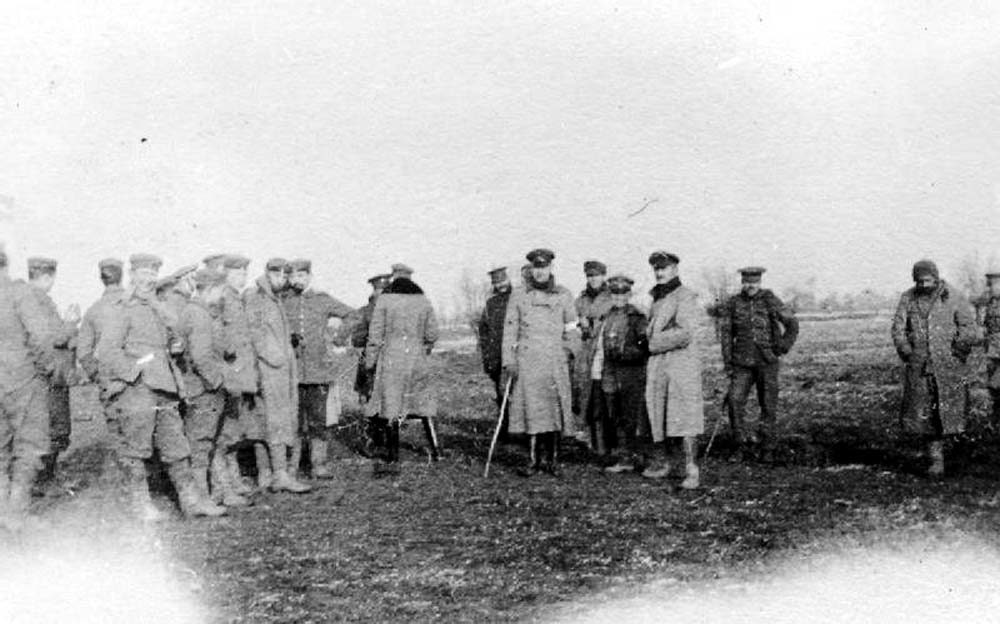
German and Britsh troops meet in No Man's Land (Wikimedia Commons)
WHAT DID THE SOLDIERS DO DURING THE CHRISTMAS TRUCE?
The image of Germans lighting candles in their trenches and the sounds of their gentle singing drifting across the killing fields of No Man’s Land has become iconic.
Along the line, German soldiers held up white flags, or messages asking the Tommies facing them not to shoot. Men that had been engaged in desperate fighting days or even hours before had begun to feel illuminated by the Christmas spirit.
Soon they were singing together, trading jokes and the odd jovial insult or two.
Marmaduke Walkinton of the London Regiment described the scene: “A German said, ‘Tomorrow you no shoot, we no shoot.’ And the morning came, and we didn’t shoot, and they didn’t shoot.
“So then we began to pop our heads over the side and jump down quickly in case they shot but they didn’t. And then we saw a German standing up, waving his arms, and we didn’t shoot, and so it gradually grew.”
Christmans day truce - A Christmas ceasefire
Christmas morning.
After the carolling and chorusing of Christmas Eve, both sides were beginning to make tentative steps over their parapets to see if the promise of at least one day of peace would be kept.
German and British soldiers bobbed their heads above their trenches to quickly survey their opposites’ intentions. Slowly, but surely, soldiers began to congregate in No Man’s Land.
It must have been an incredible sight. Men who very recently had been engaged in deadly combat now shook hands, sang songs, and exchanged gifts.
Around 100,000 or so British soldiers were said to have laid down their arms and engaged in the Christmas spirit with their German counterparts.
Corporal John Ferguson of the Second Seaforth Highlanders recalled the spontaneous scenes: “What a sight - little groups of Germans and British extending almost the length of our front! Out of the darkness we could hear laughter and see lighted matches, a German lighting a Scotchman’s cigarette and vice versa, exchanging cigarettes and souvenirs.”
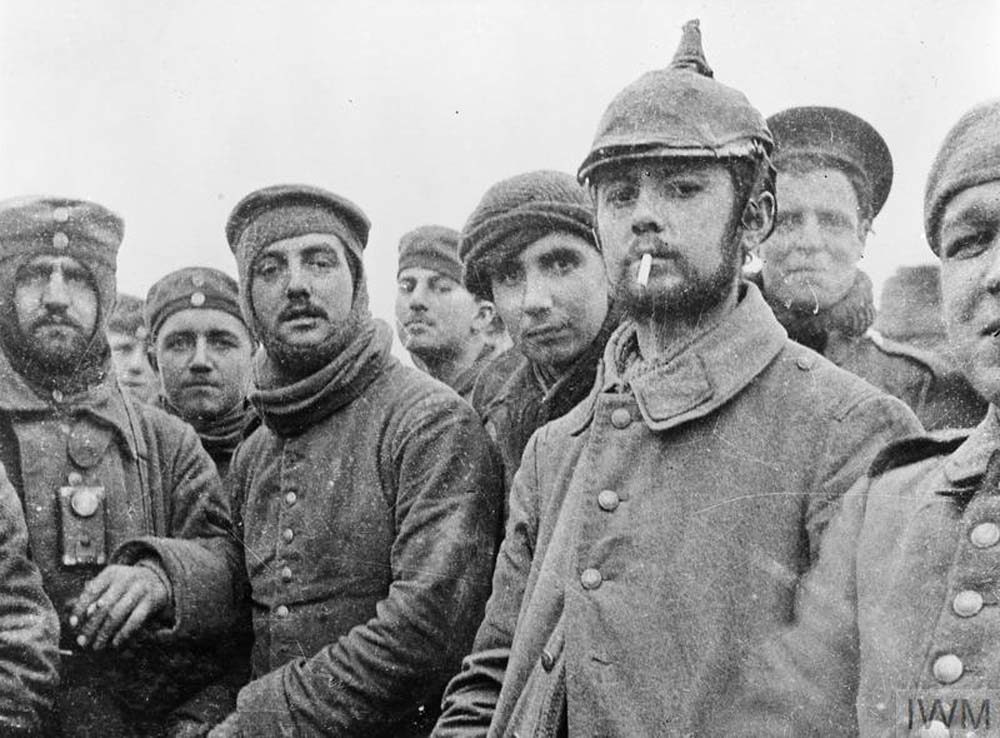
Men of the London Rifle Brigade with troops of the 104th and 106th Saxon Regiments (© IWM Q 11745)
The football match
Part of the enduring myth of the Christmas Truce is the football match.
Legend has it an organised football match took place between British and German soldiers on Christmas Day 1914. In typical fashion, the Germans are said to have bested their British opponents.
“Suddenly a Tommy came with a football, kicking already and making fun, and then began a football match,” wrote Lieutenant Johannes Niemann of the 133rd Saxon Infantry Regiment. “We marked the goals with our caps. Teams were quickly established for a match on the frozen mud, and the Fritzes beat the Tommies 3-2.”
There are lots of eyewitness testimonials from both sides saying that a football match took place. However, it’s more likely that spontaneous kickabouts took place up and down the line, rather than a single, one-off game.
DID THE CHRISTMAS TRUCE ACTUALLY HAPPEN?
For a single day, peace seemed to reign over the Western Front or at least individual sections of the trench network. Fighting was still raging on other parts of the front line.
Remember, the trench networks extended from the French and Belgian coasts to Switzerland, a distance of several hundred miles.
British and Indian troops were concentrated in Northern France and Southern Belgium. Not all of them experienced the Yuletide ceasefire.
In our records, we commemorate around 79 men who died in France and Belgium on Christmas Day 1914.
We need to be clear that, while peace did break out in certain sections of the Western Front, it was by no means a universal occurrence.
For example, the 2nd Division, stationed in the Festubert to Cuinchy Sector in the Pas-de-Calais, were under fire, especially the 2/Coldstream and 2/Grenadier Guards.
The 2nd Regiment had marched several miles from Bethune to reach their positions on 23rd/24th December in trenches east of Le Touret.
Conditions in their trenches were appalling with slush, mud, and rainwater coming in over the tops of their boots. In some cases, men were standing waist-deep in muddy water.
Whereas some British troops were serenading by German carollers on Christmas Eve, 2/Grenadier Guards were instead met by gunfire. The Battalion took a number of losses during the festive period, including 2nd Lieutenant John H.G. Neville, who had been with 2/Grenadier Guards for a scant few days.
One member of the Grenadier Guards present on Christmas Day wrote a letter home saying: “Perhaps you read of the conversation on Christmas Day. It is all lies. The sniping went on just the same; in fact, our Captain was wounded, so don’t believe what you see in the papers.”
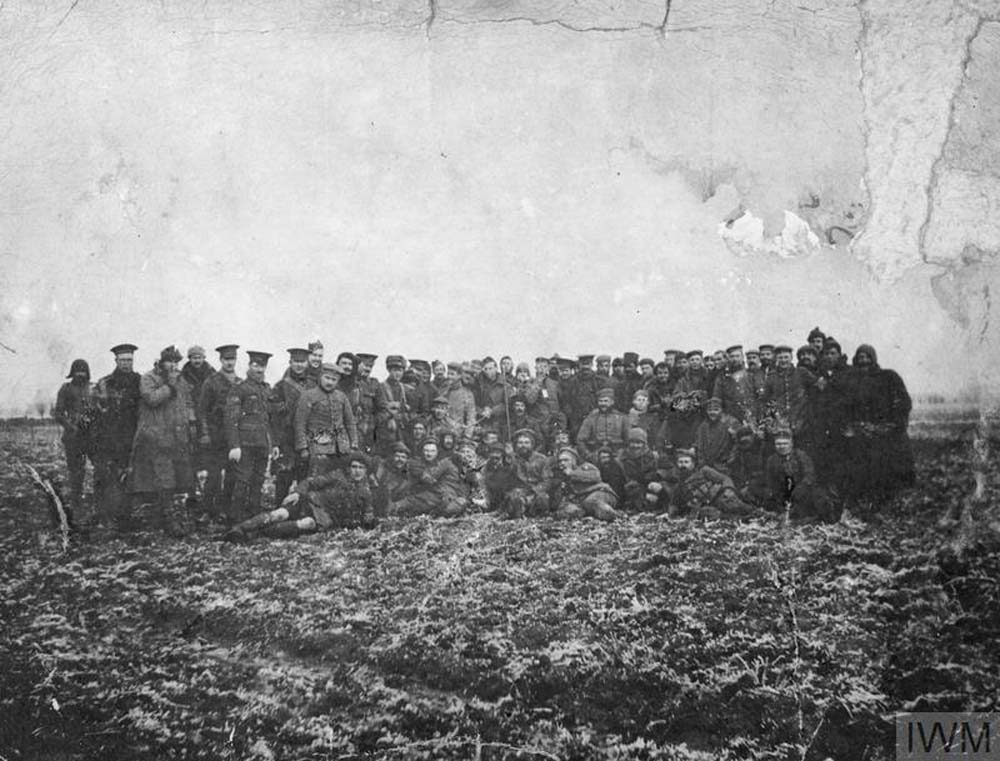
Members of the 2nd Battalion, Gordon Highlanders fraternising withn German soldiers on the Rue de Quesnes sector of the front during the Christmas Truce, 1914. Not every section of the trench network engaged in a Yuletide ceasefire, however (© IWM Q 64568)
Turning down the Truce
In some sections, peaceful overtures were made by opposing forces only for them to be ignored.
For example, the men of the 1st Battalion of the Hertfordshire regiment ignored German pleas for a temporary halt to the fighting.
Private Clifford Lane of 1/Herts recorded his units’ Christmas Eve experience.
“Later on in the night, there was a great deal of commotion going on in the German frontline, which was about 100,150 yards away,” Clifford wrote. “After a few moments, there were lighted objects raised above the German parapet looking like chines lanterns to us.
“The Germans were shouting over to our trench, there’s no doubt about that at all, and before we could take any action or do anything we were ordered to open rapid fire, you see. Which we did.”
Clifford noted the Germans did not return fire and instead continued with their Christmas celebrations.
2nd Battalion of the Welch Regiment in Festubert also experienced no cessation in the fighting. The unit’s war diary mentions their men came under heavy fire on Christmas Day, resulting in the deaths of four men.
Sniper fire was still a real danger.
The 2nd Battalion of the Monmouthshires was holding the line in the Douve-St. Yves-LeGheer sector on Christmas Morning. During the day, gunfire was minimal, and gifts were exchanged.
However, the diary of Lieutenant Frederick Brown records the tragic death of Sergeant Frank Collins. Sergeant Collins had been tasked to deliver a gift of cigarettes to Germans in the opposing trenches.
Lieutenant Brown described Collins’ death: “German soldiers beckoned him over and Collins got out and walked halfway towards them, in turn beckoning someone to come and take the gift.
“However, they called out ‘prisoner’ and immediately Collins edged back the way he had come. Suddenly a shot rang out and the poor Sgt staggered back into the trench, shot through the chest.
“I can still hear his cries, ‘Oh God, they have shot me’, and he died immediately.”
Let’s not forget, this was an active war zone. That’s what makes the Christmas Truce all the more miraculous. Where all was peaceful on the frontlines, there were still pockets of harsh fighting, killing, and dying – even on Christmas Day.
It should also be noted not everyone was in favour of the truce. While “live and let live” attitudes had prevailed early in the fighting, officers were often aghast that their men had stopped fighting.
It wasn’t uncommon for mini ceasefires to occur at the front. These allowed men to repair their trenches and recover their dead. But officers were keen to stop fraternisation or breaks in fighting. Holidays like Christmas were no excuse.
Casualty records were often scrutinised by COs to spot patterns that indicated a cessation in combat. If one was detected, raids and patrols would be organised to foster the correct “fighting spirit” in troops.
WHY DID THE CHRISTMAS TRUCE HAPPEN?
The truce began quite organically. Many of the trenches of the Western Front were within range of shouted conversation. As the guns fell silent and the soldiers slipped into the festive spirit, greetings and well wishes were exchanged, and carol singing was taken up by both sides.
Before long, men had left the trenches and were meeting their opponents in no man's land, exchanging greetings and gifts instead of bullets and bombs. Many eye witnesses speak of groups of soldiers exchanging rations and tobacco, cutting each other’s hair, and, famously, playing football.
HOW LONG DID THE CHRISTMAS TRUCE LAST?
In some cases, the truce was said to have lasted until the new year, but it most cases the little pockets of peace on the Western Front had vanished within a day or two.
Commanders on both sides were keen to ensure that this new found sense of fraternity was not allowed to spread any further, instructing their men to fire on those they had so recently been bonding with, or moving regiments to other sections of the line to dispel any sense of camaraderie their troops might have with those in the trenches opposite.
HOW DID THE CHRISTMAS TRUCE END?
There were people on both sides, both senior Commanders and enlisted men, who didn’t approve of the truce. Adolf Hitler, then merely a dispatch runner for regimental headquarters, is reported to have criticised the festive peace: “Such a thing should not happen in wartime, have you no German sense of honour?”
Similar sentiments were shared by the top brass on both sides of the trenches, and hostilities were ordered to resume the very next day. While there were no consequences or punishments handed down for this unsanctioned fraternisation, truces on this scale did not happen in the later years of the war, in part because commanding officers attempted to prevent it.
Christmas Day casualties
Below are the stories of two casualties that fell during the Yuletide period.
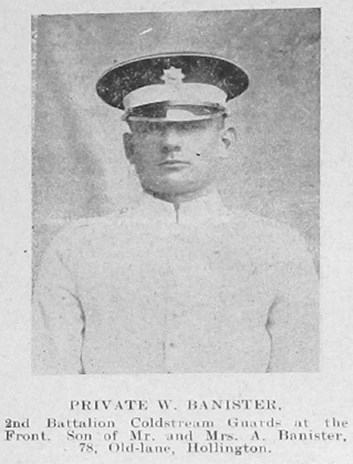
Private William Banister
Private William Banister was one of the men of the 2/Coldstream Guards engaged in bitter trench-to-trench warfare on Christmas Day 1914.
The truce was certainly not in effect on Banister and the Coldstream Guards’ part of the line.
A hail of sniper fire claimed several Guardsmen’s lives on Christmas morning. The unit’s war diary records that the accuracy of German fire could only be achieved by the use of telescopic sites.
William was one of the victims of the furious fusillade. He was just 18 years old when he was killed. He is buried in Le Touret Military Cemetery.

Lieutenant Leonard Castel Campbell Rogers
Image: © IWM HU 125125
Born in Cuttack, Orissa, India, Lieutenant Leonard Castel Campbell Rogers was serving as a Lieutenant with the 7th Gurkha Rifles in the Indian Army prior to the breakout of the Great War.
During Christmas Time 1914, Leonard and his unit were engaged in the fighting around Festubert. As we’ve discussed, combat slowed on this part of the Western Front during the festive period but did not stop.
On Christmas Eve, one of Leonard’s men lay wounded in front of his unit’s position. The man had been lying in No Man’s Land for some time, around 48 hours, but no opportunity to safely rescue him had presented itself.
Leonard led a group of men to rescue his wounded comrade under a terrific burst of enemy gunfire. Unfortunately, Leonard was struck by an errant bullet and was mortally wounded. He died on Christmas morning.
For his gallantry and bravery under fire, Leonard was posthumously awarded the Military Cross, as reported in the 23rd February 1915 edition of the Edinburgh Gazette.
Leonard is buried in Le Touret Military Cemetery.
WAS THERE A CHRISTMAS TRUCE IN WW2?
In short, no. We don’t have any records of a Christmas truce during the Second World War. There may have been small, localised truces at times, but nothing like the truce of the First World War.
Learn more about CWGC Casualties with our search tools
To discover more stories of those we commemorate and our cemeteries and memorials, don’t forget to check out our search tools.
Find War Dead lets you access our entire casualty database. If you’re tracking down a loved one or want to learn more about regimental history, this is the place to start.
Interested in visiting one of our sites? Use our Find Cemeteries & Memorials tool to discover where you will find CWGC war graves and how to get there.

